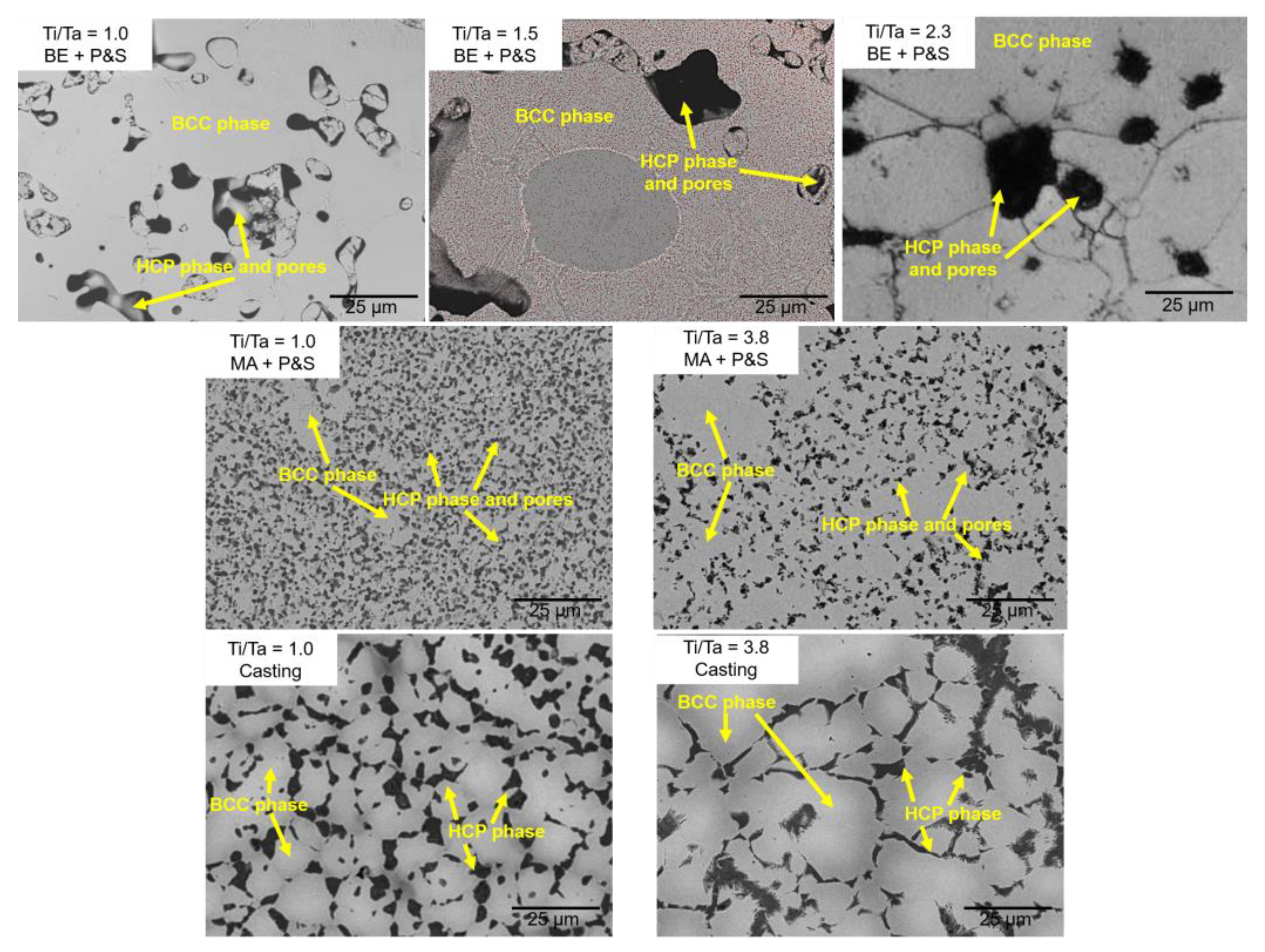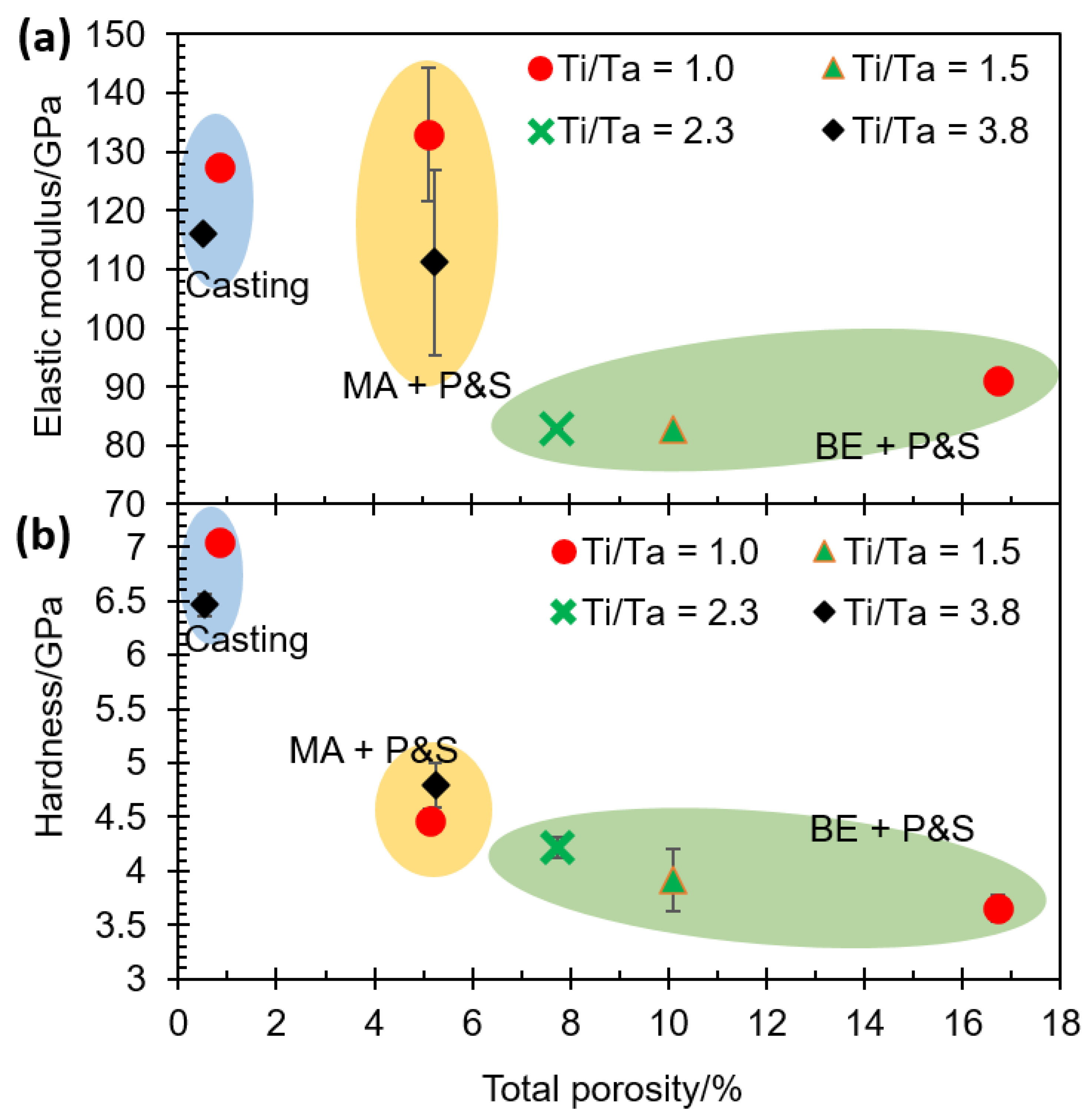The Effect of Ti/Ta Ratio and Processing Routes on the Hardness and Elastic Modulus of Porous TiNbZrTa Alloys
Abstract
:1. Introduction
2. Materials and Methods
2.1. Processing of TNZT Alloys
2.1.1. Powder Metallurgy Using the Blend Element Technique
2.1.2. Powder Metallurgy Using Mechanical Alloying
2.1.3. Arc Melting and Casting
2.2. Microstructural Characterization
2.3. Mechanical Properties Evaluation
3. Results and Discussion
4. Conclusions
- The processing methods were influenced by the high-density Ta contents (lowering the Ti/Ta ratio) and produced total porosity in the following order: casting (0.5–0.8%) < MA + P&S (5.1–5.2%) < BE + P&S (7.7–16.7%).
- The lower the Ti/Ta ratio, the higher the total porosity of the alloys.
- Elastic modulus showed a low susceptibility to the Ti/Ta ratio. Thus, Ti/Ta ratio did not show a strong effect on the bonding energy. Elastic modulus was higher for the routes with literature-based expected higher atomic diffusion (Casting: 115.9–127.3 and MA + P&S: 111.0–133 GPa) than for the BE + P&S samples (82.8–91.0 GPa). The close values of bulk elastic moduli achieved by casting and MA + P&S samples indicate similar strength of interatomic bonds. The lower porosity generated higher elastic modulus.
- Hardness was boosted in the dense cast alloys (7.0 to 6.5 GPa) compared to the porous ones (3.6 to 4.8 GPa). A decrement in hardness was observed with increasing total porosity. However, pore size and Ti/Ta ratio did not show a clear tendency on hardness among the porous alloys.
- The effect of porosity is mainly reflected in the properties associated with the microstructure (i.e., hardness), while the effect of Ti/Ta ratio is more significant in the properties related to the bonding energy (i.e., elastic modulus).
Author Contributions
Funding
Institutional Review Board Statement
Informed Consent Statement
Data Availability Statement
Conflicts of Interest
References
- King, D.J.M.; Cheung, S.T.Y.; Humphry-Baker, S.A.; Parkin, C.; Couet, A.; Cortie, M.B.; Lumpkin, G.R.; Middleburgh, S.C.; Knowles, A.J. High temperature, low neutron cross-section high-entropy alloys in the Nb-Ti-V-Zr system. Acta Mater. 2019, 166, 435–446. [Google Scholar] [CrossRef]
- George, E.P.; Raabe, D.; Ritchie, R.O. High-entropy alloys. Nat. Rev. Mater. 2019, 4, 515–534. [Google Scholar] [CrossRef]
- Castro, D.; Jaeger, P.; Baptista, A.C.; Oliveira, J.P. An overview of high-entropy alloys as biomaterials. Metals 2021, 11, 648. [Google Scholar] [CrossRef]
- Kumari, P.; Gupta, A.K.; Mishra, R.K.; Ahmad, M.S.; Shahi, R.R. A Comprehensive Review: RecentProgress on Magnetic High Entropy Alloys and Oxides. J. Magn. Magn. Mater. 2022, 554, 169142. [Google Scholar] [CrossRef]
- Ren, J.T.; Chen, L.; Wang, H.Y.; Yuan, Z.Y. High-entropy alloys in electrocatalysis: From fundamentals to applications. Chem. Soc. Rev. 2023. [Google Scholar] [CrossRef] [PubMed]
- Nasibi, S.; Alimohammadi, K.; Bazli, L.; Eskandarinezhad, S.; Mohammadi, A.; Sheysi, N. TZNT alloy for surgical implant applications: A systematic review. J. Compos. Compd. TZNT 2020, 2, 62–68. [Google Scholar] [CrossRef]
- Xiong, W.; Guo, A.X.Y.; Zhan, S.; Liu, C.T.; Cao, S.C. Refractory high-entropy alloys: A focused review of preparation methods and properties. J. Mater. Sci. Technol. 2023, 142, 196–215. [Google Scholar] [CrossRef]
- Sidhu, S.S.; Singh, H.; Gepreel, M.A.H. A review on alloy design, biological response, and strengthening of β-titanium alloys as biomaterials. Mater. Sci. Eng. C 2021, 121, 111661. [Google Scholar] [CrossRef]
- Zurita-Hurtado, O.J.; Di Graci-Tiralongo, V.C.; Capace-Aguirre, M.C. Effect of surface hardness and roughness produced by turning on the torsion mechanical properties of annealed AISI 1020 steel. Rev. Fac. Ing. 2017, 2017, 55–59. [Google Scholar] [CrossRef]
- Guo, L.; Ataollah Naghavi, S.; Wang, Z.; Nath Varma, S.; Han, Z.; Yao, Z.; Wang, L.; Wang, L.; Liu, C. On the design evolution of hip implants: A review. Mater. Des. 2022, 216, 110552. [Google Scholar] [CrossRef]
- Cui, Y.W.; Chen, L.Y.; Chu, Y.H.; Zhang, L.; Li, R.; Lu, S.; Wang, L.; Zhang, L.C. Metastable pitting corrosion behavior and characteristics of passive film of laser powder bed fusion produced Ti–6Al–4V in NaCl solutions with different concentrations. Corros. Sci. 2023, 215, 111017. [Google Scholar] [CrossRef]
- Raducanu, D.; Cojocaru, V.D.; Nocivin, A.; Cinca, I.; Serban, N.; Cojocaru, E.M. Contributions to Mechanical Characteristics Improvement of Some Biomedical TNTZ Alloys by Adding Fe, Si, and O: A Comparative Study. Jom 2019, 71, 264–271. [Google Scholar] [CrossRef]
- Kopova, I.; Stráský, J.; Harcuba, P.; Landa, M.; Janeček, M.; Bačákova, L. Newly developed Ti-Nb-Zr-Ta-Si-Fe biomedical beta titanium alloys with increased strength and enhanced biocompatibility. Mater. Sci. Eng. C 2016, 60, 230–238. [Google Scholar] [CrossRef] [PubMed]
- Zareidoost, A.; Yousefpour, M. A study on the mechanical properties and corrosion behavior of the new as-cast TZNT alloys for biomedical applications. Mater. Sci. Eng. C 2020, 110, 110725. [Google Scholar] [CrossRef] [PubMed]
- Yang, M.; Shao, L.; Duan, J.M.; Chen, X.T.; Tang, B.Y. Temperature dependence of mechanical and thermodynamic properties of Ti(25+x)Zr25Nb25Ta(25-x) (x ≤ 20) refractory high entropy alloys: Influences of substitution of Ti for Ta. Phys. B Condens. Matter 2021, 606, 412851. [Google Scholar] [CrossRef]
- Al Hawajreh, G.; Gonzalez, G.; Romero-Resendiz, L.; Vidilli, A.; Otani, L.B.; Amigó, V. Effect of the Ti/Ta ratio on the feasibility of porous Ti25+x-Nb25-Zr25-Ta25-x (X= 0, 5, and 10) alloys for biomedical applications. J. Mater. Res. Technol. 2023, 24, 109181. [Google Scholar] [CrossRef]
- Zhang, R.; Zhao, S.; Ding, J.; Chong, Y.; Jia, T.; Ophus, C.; Asta, M.; Ritchie, R.O.; Minor, A.M. Short-range order and its impact on the CrCoNi medium-entropy alloy. Nature 2020, 581, 283–287. [Google Scholar] [CrossRef]
- Ching, W.Y.; San, S.; Brechtl, J.; Sakidja, R.; Zhang, M.; Liaw, P.K. Fundamental electronic structure and multiatomic bonding in 13 biocompatible high-entropy alloys. Npj Comput. Mater. 2020, 6, 1–10. [Google Scholar] [CrossRef]
- Bram, M.; Ebel, T.; Wolff, M.; Cysne Barbosa, A.P.; Tuncer, N. Applications of powder metallurgy in biomaterials. In Advances in Powder Metallurgy; Woodhead Publishing: Cambridge, UK, 2013; pp. 520–554. ISBN 9780857094209. [Google Scholar]
- Keist, J.S.; Palmer, T.A. Development of strength-hardness relationships in additively manufactured titanium alloys. Mater. Sci. Eng. A 2017, 693, 214–224. [Google Scholar] [CrossRef]
- Fan, X.; Qu, R.; Zhang, Z. Relation Between Strength and Hardness of High-Entropy Alloys. Acta Metall. Sin. 2021, 34, 1461–1482. [Google Scholar] [CrossRef]
- ASTM B962-17. Standard Test Methods for Density of Compacted or Sintered Powder Metallurgy (PM) Products Using Archimedes’ Principle. Available online: https://webstore.ansi.org/standards/astm/astmb96217?gad_source=1&gclid=EAIaIQobChMIotbX14vjggMV9KJmAh0bAgTNEAAYASAAEgIZI_D_BwE (accessed on 1 October 2023).
- Suryanarayana, C. Mechanical alloying: A critical review. Mater. Res. Lett. 2022, 10, 619–647. [Google Scholar] [CrossRef]
- Tai, H.; Mather, M.L.; Howard, D.; Wang, W.; White, L.J.; Crowe, J.A.; Morgan, S.P.; Chandra, A.; Williams, D.J.; Howdle, S.M.; et al. Control of pore size and structure of tissue engineering scaffolds produced by supercritical fluid processing. Eur. Cells Mater. 2007, 14, 64–76. [Google Scholar] [CrossRef] [PubMed]
- Cavaliere, P. Spark Plasma Sintering of Materials: Advances in Processing and Applications; Springer: Cham, Switzerland, 2019; ISBN 9783030053277. [Google Scholar]
- Imao, H.; Kishida, S.; Tokutaka, H. Effects of starting powders and cooling process on the growth of Bi2Sr2CaCu2Oy single crystals. Phys. C Supercond. 2001, 357–360, 719–721. [Google Scholar] [CrossRef]
- Roy, A.; Munshi, J.; Balasubramanian, G. Low energy atomic traps sluggardize the diffusion in compositionally complex refractory alloys. Intermetallics 2021, 131, 107106. [Google Scholar] [CrossRef]
- Fryxell, R.E.; Chandler Creep, B.A. Strength, Expansion, and Elastic Moduli of sintered BeO as a function of grain size, porosity and grain orientation. J. Am. Ceram. Soc. 1964, 47, 283–291. [Google Scholar] [CrossRef]
- Choren, J.A.; Heinrich, S.M.; Silver-Thorn, M.B. Young’s modulus and volume porosity relationships for additive manufacturing applications. J. Mater. Sci. 2013, 48, 5103–5112. [Google Scholar] [CrossRef]
- Mohammed, M.T. Beta Titanium Alloys: The Lowest Elastic Modulus for Biomedical Applications: A Review Surface processing and alloying View project Powder Metallurgy Titanium Alloys View project. Int. J. Mater. Metall. Eng. 2014, 8, 822–827. [Google Scholar]
- Wolverton, C. Solute-vacancy binding in aluminum. Acta Mater. 2007, 55, 5867–5872. [Google Scholar] [CrossRef]
- Correa-Rossi, M.; Romero-Resendiz, L.; Leal-Bayerlein, D.; Garcia-Alves, A.; Segovia-López, F.; Amigó-Borrás, V. Mechanical, Corrosion, and Ion Release Studies of Ti-34Nb-6Sn Alloy with Comparable to the Bone Elastic Modulus by Powder Metallurgy Method. Powders 2022, 1, 3–17. [Google Scholar] [CrossRef]
- Romero-Resendiz, L.; Gómez-Sáez, P.; Vicente-Escuder, A.; Amigó-Borrás, V. Development of Ti-In alloys by powder metallurgy for application as dental biomaterial. J. Mater. Res. Technol. 2021, 11, 1719–1729. [Google Scholar] [CrossRef]
- Xu, J.L.; Bao, L.Z.; Liu, A.H.; Jin, X.F.; Luo, J.M.; Zhong, Z.C.; Zheng, Y.F. Effect of pore sizes on the microstructure and properties of the biomedical porous NiTi alloys prepared by microwave sintering. J. Alloys Compd. 2015, 645, 137–142. [Google Scholar] [CrossRef]
- Beltrán, A.M.; Civantos, A.; Dominguez-Trujillo, C.; Moriche, R.; Rodríguez-Ortiz, J.A.; García-Moreno, F.; Webster, T.J.; Kamm, P.H.; Restrepo, A.M.; Torres, Y. Porous titanium surfaces to control bacteria growth: Mechanical properties and sulfonated polyetheretherketone coatings as antibiofouling approaches. Metals 2019, 9, 995. [Google Scholar] [CrossRef]
- Romero-Resendiz, L.; Rossi, M.C.; Segui-Esquembre, C.; Amigo-Borras, V. Development of a porous Ti-35Nb-5In alloy with low elastic modulus for biomedical implants. J. Mater. Res. Technol. 2023, 22, 1151–1164. [Google Scholar] [CrossRef]
- Furukawa, M.; Horita, Z.; Nemoto, M.; Valiev, R.Z.; Langdon, T.G. Factors influencing the flow and hardness of materials with ultrafine grain sizes. Philos. Mag. A 1998, 78, 203–216. [Google Scholar] [CrossRef]




| Raw Material | Purity/ wt.% | Average Particle Size/µm | Structure | Density/ g cm−3 | Melting Point/°C |
|---|---|---|---|---|---|
| Ti | 99.9 | 44 | HCP | 4.5 | 1668 |
| Nb | 99.8 | 1–5 | BCC | 8.5 | 2477 |
| ZrH2 | 99.9 | 4.5–6.5 | FCC | 5.6 | 800 |
| Ta | 99.9 | 1–5 | BCC | 16.6 | 3020 |
| Chemical Composition/at.% | Ti/Ta Ratio | Production Route | Density/g cm−3 |
|---|---|---|---|
| Ti25Nb25Zr25Ta25 (equiatomic) | 1.0 | BE + P&S | 8.9 |
| Ti30Nb25Zr25Ta20 | 1.5 | BE + P&S | 8.3 |
| Ti35Nb25Zr25Ta15 | 2.3 | BE + P&S | 7.7 |
| Ti25Nb25Zr25Ta25 (equiatomic) | 1.0 | MA + P&S | 8.9 |
| Ti43.1Nb22.1Zr22.5Ta11.3 (equimassic) | 3.8 | MA + P&S | 7.2 |
| Ti25Nb25Zr25Ta25 (equiatomic) | 1.0 | Casting | 8.9 |
| Ti43.1Nb22.1Zr22.5Ta11.3 (equimassic) | 3.8 | Casting | 7.2 |
Disclaimer/Publisher’s Note: The statements, opinions and data contained in all publications are solely those of the individual author(s) and contributor(s) and not of MDPI and/or the editor(s). MDPI and/or the editor(s) disclaim responsibility for any injury to people or property resulting from any ideas, methods, instructions or products referred to in the content. |
© 2023 by the authors. Licensee MDPI, Basel, Switzerland. This article is an open access article distributed under the terms and conditions of the Creative Commons Attribution (CC BY) license (https://creativecommons.org/licenses/by/4.0/).
Share and Cite
González-Guillén, C.; Al Hawajreh Kamel, G.; Degalez-Duran, E.; Klyatskina, E.; Naeem, M.; Romero-Resendiz, L.; Gonzalez, G.; Amigó Borrás, V. The Effect of Ti/Ta Ratio and Processing Routes on the Hardness and Elastic Modulus of Porous TiNbZrTa Alloys. Materials 2023, 16, 7362. https://doi.org/10.3390/ma16237362
González-Guillén C, Al Hawajreh Kamel G, Degalez-Duran E, Klyatskina E, Naeem M, Romero-Resendiz L, Gonzalez G, Amigó Borrás V. The Effect of Ti/Ta Ratio and Processing Routes on the Hardness and Elastic Modulus of Porous TiNbZrTa Alloys. Materials. 2023; 16(23):7362. https://doi.org/10.3390/ma16237362
Chicago/Turabian StyleGonzález-Guillén, Celia, Ghaith Al Hawajreh Kamel, Eduardo Degalez-Duran, Elizaveta Klyatskina, Muhammad Naeem, Liliana Romero-Resendiz, Gonzalo Gonzalez, and Vicente Amigó Borrás. 2023. "The Effect of Ti/Ta Ratio and Processing Routes on the Hardness and Elastic Modulus of Porous TiNbZrTa Alloys" Materials 16, no. 23: 7362. https://doi.org/10.3390/ma16237362








